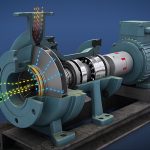The Chainsaw Market: Powering Agricultural Innovation and Land Management Excellence
Key Takeaways
- The global chainsaw market is experiencing steady growth. It was valued at USD 4.39 billion in 2024 and projected to reach USD 6.46 billion by 2035.
- Agricultural applications extend far beyond traditional forestry, encompassing farm maintenance, land clearing, and timber processing.
- Professional-grade chainsaws dominate the market due to their durability and performance requirements in commercial agriculture.
- Electric and battery-powered chainsaws are gaining traction as sustainable alternatives in eco-conscious farming operations.
- North America and Europe lead market demand, driven by extensive agricultural land use and mechanization trends.
- Safety innovations and ergonomic improvements are becoming critical differentiators for manufacturers.
- The rise of precision agriculture is creating new opportunities for specialized chainsaw applications.
- Integration of IoT and smart technologies is transforming traditional chainsaw functionality and maintenance practices.
Market Overview
The chainsaw market represents a dynamic and evolving sector within the broader agricultural machinery industry, demonstrating remarkable resilience and consistent growth patterns. With a current valuation of USD 4.39 billion in 2024, the market’s trajectory toward USD 6.46 billion by 2035 reflects a compound annual growth rate of 3.60%, indicating robust demand across multiple agricultural segments. This growth trajectory is particularly significant when considering the diverse applications of chainsaws beyond traditional logging operations.
Chainsaws have become indispensable tools for modern farming operations, serving critical functions in land management, crop maintenance, and infrastructure development. Farmers and agricultural professionals increasingly rely on these versatile machines for tasks ranging from pruning fruit trees and clearing overgrown pastures to processing timber for farm construction and maintaining windbreaks. The evolution of chainsaw technology has paralleled the advancement of agricultural practices, with manufacturers developing specialized models tailored to specific farming applications.
Get a Sample Copy:- https://www.vantagemarketresearch.com/chain-saw-market-0896/request-sample
The market’s expansion is driven by several interconnected factors, including the growing global population’s demand for food production, the need for efficient land utilization, and the increasing mechanization of agricultural operations. Modern chainsaws offer enhanced fuel efficiency, reduced emissions, and improved safety features, making them more attractive to environmentally conscious farmers and agricultural businesses. Additionally, the integration of precision agriculture techniques has created new opportunities for chainsaw applications in sustainable farming practices.
The competitive landscape encompasses both established manufacturers with decades of experience and innovative newcomers introducing cutting-edge technologies. This diversity fosters continuous innovation, resulting in products that better serve the evolving needs of agricultural professionals. The market’s stability is further reinforced by the essential nature of chainsaw applications in agriculture, ensuring consistent demand regardless of economic fluctuations. As agricultural operations become increasingly sophisticated and environmentally focused, the chainsaw market continues to adapt, offering solutions that balance performance, sustainability, and cost-effectiveness.
Market Segmentation Analysis
The chainsaw market exhibits diverse segmentation patterns that reflect the varied needs of agricultural users and applications. Product-wise segmentation reveals distinct categories including gas-powered chainsaws, electric corded models, and battery-powered units, each serving specific agricultural requirements. Gas-powered chainsaws dominate the professional agriculture segment due to their superior power output and portability, making them ideal for heavy-duty tasks such as land clearing and large-scale timber processing. These models typically feature engines ranging from 35cc to over 100cc, providing the necessary torque for demanding agricultural applications.
Electric chainsaws, both corded and battery-powered, are gaining significant traction in agricultural markets, particularly for precision tasks and environmentally sensitive operations. Battery-powered models offer the advantage of zero emissions and reduced noise levels, making them suitable for operations near residential areas or in organic farming contexts where environmental impact is a primary concern. The advancement in lithium-ion battery technology has substantially improved the runtime and power delivery of these units, making them viable alternatives for many agricultural applications.
Application-based segmentation reveals distinct usage patterns across different agricultural sectors. Orchard management represents a significant segment, where chainsaws are essential for pruning, tree removal, and canopy management. Livestock operations utilize chainsaws for pasture maintenance, fence line clearing, and shelter construction. Crop farming applications include removing storm-damaged trees, clearing irrigation channels, and maintaining farm infrastructure. The diversification of applications has prompted manufacturers to develop specialized features such as lightweight designs for extended use, low-vibration systems for operator comfort, and quick-start mechanisms for efficiency in time-sensitive agricultural tasks.
Drivers
The chainsaw market’s growth in agriculture is propelled by several fundamental drivers that reflect broader trends in modern farming practices. The increasing global food demand necessitates more efficient land utilization, driving farmers to clear previously unused land and optimize existing agricultural areas. Chainsaws play a crucial role in this expansion, enabling rapid land preparation and maintaining agricultural productivity across diverse terrain types. The mechanization of agriculture continues to accelerate, with farmers seeking tools that enhance operational efficiency while reducing labor costs and time investment.
Climate change adaptation strategies have become significant market drivers, as extreme weather events require farmers to quickly respond to storm damage and implement protective measures. Chainsaws provide the necessary capability to clear fallen trees, remove damaged vegetation, and maintain emergency access routes on agricultural properties. Additionally, the growing emphasis on sustainable forestry practices within agricultural operations has increased demand for precision cutting tools that minimize environmental impact while maximizing resource utilization.
Technological advancements in chainsaw design and functionality serve as powerful market drivers. Features such as anti-vibration systems, automatic chain lubrication, and ergonomic designs attract agricultural professionals who prioritize operator comfort and safety. The integration of smart technologies, including maintenance reminders and performance monitoring, appeals to tech-savvy farmers seeking to optimize equipment utilization and reduce operational costs through predictive maintenance strategies.
Restraints
Despite strong growth prospects, the chainsaw market faces several constraints that impact agricultural adoption and market expansion. Safety concerns remain a primary restraint, as chainsaws present inherent risks that require comprehensive training and safety protocols. Many agricultural operations, particularly smaller farms, struggle with the cost and time investment required for proper operator training and safety compliance. Insurance and liability considerations also influence purchasing decisions, with some agricultural businesses hesitant to invest in chainsaw equipment due to potential workplace safety risks.
Environmental regulations and emissions standards pose increasing challenges for traditional gas-powered chainsaws, particularly in regions with strict air quality requirements. Agricultural operations in environmentally sensitive areas face restrictions on equipment usage that may limit chainsaw applications during certain seasons or conditions. The transition to cleaner technologies often requires higher initial investments, creating barriers for cost-conscious agricultural businesses.
Maintenance requirements and operational costs represent ongoing restraints, as chainsaws require regular servicing, blade sharpening, and component replacement to maintain optimal performance. For agricultural operations with limited technical expertise or access to service facilities, these maintenance demands can become prohibitive. Additionally, the seasonal nature of many agricultural applications means chainsaws may remain idle for extended periods, raising concerns about equipment degradation and return on investment for some farming operations.
Growth Factors
Multiple growth factors support the chainsaw market’s expansion in agriculture, creating sustained demand and market development opportunities. The trend toward sustainable agriculture practices has increased focus on selective harvesting, precision pruning, and careful vegetation management, applications where chainsaws provide unmatched versatility and control. Agricultural businesses are increasingly recognizing the value of maintaining healthy tree populations for erosion control, wildlife habitat, and carbon sequestration, creating new applications for chainsaw technology in environmental stewardship.
Technological innovations continue to drive market growth, with manufacturers developing increasingly sophisticated features that enhance productivity and user experience. Advanced chain technologies, improved fuel efficiency, and reduced emissions attract environmentally conscious agricultural operations. The development of specialized attachments and accessories expands chainsaw functionality, enabling agricultural professionals to perform multiple tasks with a single piece of equipment, thereby improving operational efficiency and reducing equipment costs.
The growth of agritourism and diversified farming operations creates additional demand for chainsaws in maintaining recreational areas, trails, and aesthetic landscaping on agricultural properties. This trend particularly benefits smaller and mid-sized farms seeking to supplement income through tourism activities, where well-maintained outdoor spaces become essential business assets.
Emerging Trends
The chainsaw market is experiencing significant transformation through emerging trends that reshape how agricultural professionals approach land management and equipment selection. The electrification trend represents perhaps the most significant development, with battery-powered chainsaws achieving performance levels that rival traditional gas-powered models. Advanced lithium-ion battery systems now provide extended runtime and consistent power delivery, making electric chainsaws viable for increasingly demanding agricultural applications. This shift aligns with broader sustainability goals in agriculture, where reducing carbon footprints and minimizing environmental impact have become operational priorities.
Smart technology integration is revolutionizing chainsaw functionality, with manufacturers incorporating IoT sensors, GPS tracking, and performance monitoring systems into their equipment. These innovations enable predictive maintenance, usage optimization, and fleet management capabilities that appeal to large-scale agricultural operations. Some models now feature smartphone connectivity, allowing operators to monitor equipment status, track maintenance schedules, and access operational data remotely. This technological advancement particularly benefits agricultural contractors and commercial operations managing multiple chainsaw units across extensive properties.
The customization trend is gaining momentum as manufacturers recognize the diverse needs of agricultural applications. Specialized models designed for specific tasks such as fruit tree pruning, forestry management, and land clearing are becoming more prevalent. These purpose-built chainsaws feature optimized power-to-weight ratios, specialized cutting chains, and ergonomic designs tailored to specific agricultural workflows. Additionally, the trend toward modular design allows agricultural professionals to adapt their equipment for different tasks through interchangeable components and attachments.
Automation and semi-autonomous technologies are beginning to emerge in the chainsaw market, with some manufacturers exploring robotic applications for repetitive tasks such as pruning and vegetation management. While still in early development stages, these innovations suggest future possibilities for reduced labor requirements and enhanced precision in agricultural chainsaw applications.
Regional Analysis
The global chainsaw market exhibits distinct regional characteristics that reflect local agricultural practices, economic conditions, and regulatory environments. North America maintains a dominant position in the agricultural chainsaw market, driven by extensive farmland, advanced mechanization practices, and strong purchasing power among agricultural professionals. The United States and Canada represent the largest markets in this region, with significant demand from both commercial agriculture and specialty farming operations. The prevalence of large-scale farming operations in the Midwest and extensive forestry activities in the Pacific Northwest contribute to sustained market demand.
European markets demonstrate strong growth in premium and environmentally focused chainsaw segments, reflecting the region’s emphasis on sustainable agriculture and strict environmental regulations. Countries such as Germany, France, and the United Kingdom lead in the adoption of electric and low-emission chainsaw technologies, driven by both regulatory requirements and consumer preferences for environmentally responsible farming practices. The European market also shows significant demand for specialized agricultural applications, including vineyard management and organic farming operations where precision and environmental impact are critical considerations.
The Asia-Pacific region represents the fastest-growing segment of the agricultural chainsaw market, with countries like China, India, and Australia driving demand through agricultural modernization and land development initiatives. China’s massive agricultural sector and ongoing mechanization efforts create substantial market opportunities, while Australia’s extensive pastoral operations and forestry activities contribute to steady demand growth. Emerging economies in Southeast Asia are increasingly adopting mechanized farming practices, creating new market opportunities for chainsaw manufacturers seeking to expand their global presence.
Competitive Landscape
The chainsaw market’s competitive environment reflects a dynamic interplay between established industry leaders and innovative newcomers, each seeking to capture market share through technological advancement and strategic positioning. Market leaders such as STIHL, Husqvarna, and Echo have built strong reputations through decades of innovation and reliability, establishing extensive dealer networks and service infrastructures that serve agricultural customers worldwide. These companies continue to invest heavily in research and development, focusing on improving fuel efficiency, reducing emissions, and enhancing user safety features that appeal to professional agricultural users.
Stihl maintains its position as a market leader through continuous innovation and a strong focus on professional-grade equipment tailored to agricultural applications. The company’s extensive product line includes specialized models for various agricultural tasks, from lightweight pruning saws to heavy-duty land-clearing equipment. Their commitment to dealer support and service excellence has created strong brand loyalty among agricultural professionals who value reliable equipment and accessible maintenance services.
Husqvarna has differentiated itself through technological innovation, particularly in the development of battery-powered chainsaws and smart technology integration. Their focus on ergonomic design and user-friendly features appeals to agricultural operators who prioritize comfort and efficiency during extended use periods. The company’s investment in sustainable technology aligns with the growing environmental consciousness in agricultural markets.
Emerging competitors are challenging established players by focusing on specific market segments and innovative technologies. Companies specializing in electric chainsaws are gaining traction as battery technology improves and environmental regulations become more stringent. These newcomers often offer competitive pricing and innovative features that appeal to cost-conscious agricultural operators seeking alternatives to traditional gas-powered equipment.
The competitive landscape is further shaped by strategic partnerships and acquisitions, as companies seek to expand their technological capabilities and market reach. Collaborations between chainsaw manufacturers and technology companies are becoming more common, resulting in products that integrate advanced features such as GPS tracking, performance monitoring, and predictive maintenance capabilities. This technological convergence is creating new competitive dynamics that favor companies that are able to successfully integrate traditional manufacturing expertise with modern digital capabilities.
Recent Developments in the Chainsaw Market
- STIHL introduced the MSA 300 C battery-powered chainsaw, specifically designed for professional forestry and agricultural applications, featuring a 36V lithium-ion battery system and equivalent performance to 50cc gas models.
- Husqvarna launched their 540i XP battery chainsaw with advanced connectivity features, including smartphone app integration for maintenance tracking and performance optimization.
- Echo developed the DCS-2511T top-handle chainsaw, which features improved ergonomics and reduced weight. It is targeted at arborists and agricultural professionals who require precision cutting capabilities.
- Makita expanded their outdoor power equipment line with the XCU09 18V X2 chainsaw, offering tool-less chain adjustment and automatic chain oiling for agricultural convenience.
- Oregon introduced their PowerNow CS300 electric chainsaw with instant start technology and reduced maintenance requirements, appealing to occasional agricultural users.
- Craftsman launched the V60 60V MAX chainsaw with brushless motor technology, providing extended runtime and consistent power delivery for agricultural applications.
- Greenworks developed the Pro 80V chainsaw system with interchangeable batteries across their entire outdoor power equipment line, offering operational flexibility for diversified farming operations.
- DeWalt introduced the DCCS670 FlexVolt chainsaw with adaptive power technology that automatically adjusts performance based on cutting conditions and material density.
Market Segmentation
Parameter
Details
Segment Covered
- Gasoline-Powered (52.2%)
- Gas-Powered
- Electric-Powered
- Residential
- Commercial (62.3%)
- North America
- Europe
- Asia Pacific
- Latin America
- Middle east & Africa
Regions & Countries Covered
- North America
- Europe
- Asia Pacific
- Latin America
- Middle east & Africa
- North America Europe Asia Pacific Latin America Middle east & Africa
Companies Covered
- Husqvarna AB
- Yamabiko Corp.
- SUMEC Group Corporation
- STIGA S.p.A.
- The Toro Co.
- Hitachi Ltd.
- Makita
- Emak SPA
- Talon Tough Tools
- Robert Bosch GmbH
- Einhell Germany
- Blount International Inc.
- Stanley Black & Decker Inc.
- ANDREAS STIHL LIMITED
- Rochford Garden Machinery
- AL-KO Kober.
Report Coverage
Market growth drivers, restraints, opportunities, Porter’s five forces analysis, PEST analysis, value chain analysis, regulatory landscape, technology landscape, patent analysis, market attractiveness analysis by segments and North America, company market share analysis, and COVID-19 impact analysis
Pricing and purchase options
Avail of customized purchase options to meet your exact research needs.Explore purchase options
FAQs
- What are the primary applications of chainsaws in modern agriculture beyond traditional logging?
- How do battery-powered chainsaws compare to gas-powered models in terms of performance and suitability for agricultural tasks?
- What safety training and certification requirements should agricultural workers complete before operating chainsaws?
- Which chainsaw specifications are most important for fruit tree pruning and orchard management applications?
- How do environmental regulations impact chainsaw selection and usage in agricultural operations?
- What maintenance practices are essential for extending chainsaw lifespan in agricultural environments?
- How can agricultural businesses evaluate the return on investment for different chainsaw models and technologies?
- What are the key differences between professional-grade and consumer-grade chainsaws for agricultural use?
- How do seasonal usage patterns affect chainsaw selection and maintenance planning in agriculture?
- What emerging technologies are likely to impact chainsaw applications in agriculture over the next decade?
![[Market Research Reports] – Research Google News Blog | VMR.Biz](https://www.vmr.biz/wp-content/uploads/2022/12/logo-removebg-preview.png)











